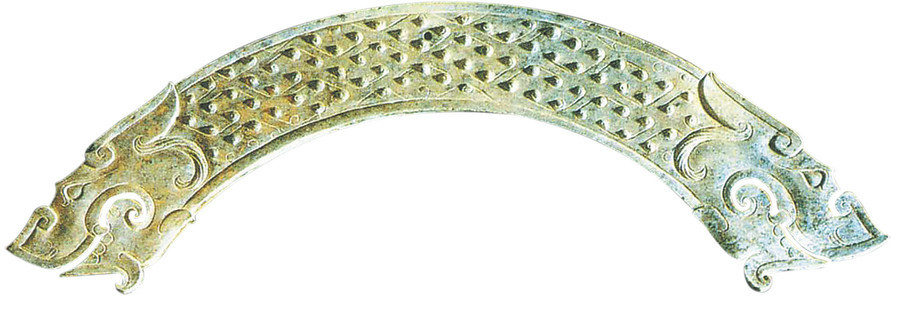

It was the continual, omnidirectional flow of communication among the nation's ancient cultures that helped to form the foundation of Chinese civilization as we know it today, Zhao Xu reports.
'With the help of jade, people who inhabited the vast area of prehistoric China had engaged in spiritual and artistic exchanges, exchanges that would eventually allow them to acquire a common cultural identity without which the notion of China would not have existed," says Teng Shu-ping, a leading scholar of ancient Chinese jade.
She has partly based her conclusion on the study of one particular type of ritual jadeware known as cong, which typically features a cylindrical tube encased in a square prism.
Today, for the general public, the most famous jade cong pieces come from the Liangzhu culture, a regional civilization that existed in the Yangtze River Delta region between 3300 and 2300 BC. The most finely made examples bear, across their surface, patterns of a mythical man donning a feather headdress and seemingly riding a big-eyed, wide-mouthed beast — interpreted separately as both ancestor-god and divine animal.
Well studied, they are long held by many Chinese archaeologists as the ancestors for the jade cong found in other, later cultures, including Qijia (2300-1500 BC), a late Neolithic to early Bronze Age culture centered around the upper Yellow River region in today's Gansu province in northwestern China.
One of them is Fang Xiangming, head of the Zhejiang provincial institute of cultural relics and archaeology, who had once spent more than six months recording many Liangzhu jade items through hand-drawing. "Never underestimate the ability of our ancestors to pass on materials and ideas across distances and generations," he says. "Such exchanges may have been enabled by a trans-regional network maintained by the elite members of the various cultural groups."
Teng both agrees and disagrees with Fang. "The exchanges had always been taking place, to an extent that often challenges our imagination. However, we shouldn't assume that the jade cong had originated in Liangzhu in eastern China. For one, jade cong pieces have also been discovered in Miaodigou culture, which existed between 3500 and 2900 BC in Shaanxi province, northwestern China."
"In fact, I am tempted to think the contrary."
In an article she wrote that appears in the catalogue for an exhibition of ancient Chinese jadeware, held previously at the Nanjing Museum, Teng elaborated on her idea. "By 3500 BC, jade pieces were being made across China to serve various purposes, among which was the facilitation of communication between the heaven and the earth, the mortal and the immortal," she wrote. "While eastern China at the time featured mainly watery lowlands — it still does today — the expansive terrain in western China gradually rose up to form plateaus with a dry climate. The two parts were further divided by a chain of mountain ranges that runs northeast to southwest.
"These geographical and environmental factors had most likely worked their way into the jade cultures that developed relatively independently in the two vast regions. In the east, a strong animal worship formed; in the west, primitive veneration of celestial bodies evolved," she says, citing Liangzhu and Qijia as salient examples of the two traditions.
Asked whether this was because the warm, humid weather of eastern China was more of a haven for animals, while the western highlands lent their inhabitants an unhindered panorama, making them feel closer to the heavens, Teng says that, although this might be the case, she would generally refrain from saying so, since jade and pottery items produced in the western regions around this time also featured a variety of animal images.